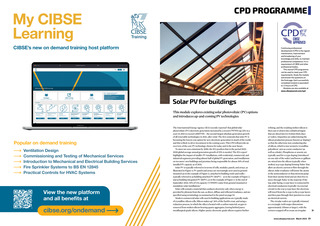


CPD PROGRAMME Source Polysolar, www.polysolar.co.uk. All rights reserved Continuing professional development (CPD) is the regular maintenance, improvement and broadening of your knowledge and skills, to maintain professional competence. It is a requirement of CIBSE and other professional bodies. This Journal CPD programme can be used to meet your CPD requirements. Study the module and answer the questions on the final page. Each successfully completed module is equivalent to 1.5 hours of CPD. Modules are also available at www.cibsejournal.com/cpd Solar PV for buildings This module explores existing solar photovoltaic (PV) options and introduces up-and-coming PV technologies The International Energy Agency (IEA) recently reported1 that global solar photovoltaic (PV) electricity generation increased by a record 179TWh (up 22% in a year) in 2021 to exceed 1,000TWh the second-largest absolute generation growth of all renewable technologies in 2021, after wind. The IEA contends that solar PV is becoming the lowest-cost option for new electricity generation in much of the world, and this is likely to drive investment in the coming years. This CPD will provide an overview of the core PV technology choices for today and in the near future. To meet net zero emissions by 2050, the IEA predicts that in the period 20222030 global average annual generation growth of 25% is needed. The IEA report1 highlights the impact of smaller PV installations, with residential, commercial, and industrial segments providing almost half of global PV generation, and installations on investors own buildings and premises being responsible for almost 30% of total installed PV capacity as of 2021. Solar PV is typically referred to in terms of cells, modules, panels, and arrays, as illustrated in Figure 4. PV panels and arrays are increasingly seen used as groundmounted (as in the example of Figure 1), attached to building roofs (and walls) typically referred to as building attached PV (BAPV) as in the example of Figure 2, and as building integrated PV (BIPV), as in the example of Figure 3. At the end of September 2022, 55% of UK capacity (7,739MW) came from ground-mounted or standalone solar installations.2 Solar cells contain a material that conducts electricity only when energy is provided by photons from the sun, as direct, diffuse and reflected irradiance, and are specified using terminology as summarised in the panel on page 53. Modern commercial solar cells used in building applications are typically made of crystalline silicon cells. Silicon makes up3 26% of the Earths crust, and using a reduction process, in which the silica is heated with a carbon material, oxygen is removed from molten silicon-bearing quartz aggregates, leaving behind purer, metallurgical-grade silicon. Higher-purity electronic-grade silicon requires further refining, and the resulting molten silicon is then cast or drawn into cylindrical ingots that are sliced into 0.2-0.5mm thick discs or wafers. Impurities are added during the silicon production process (known as doping) so that the otherwise non-conducting disc of silicon, which is now termed a crystalline polysilicon, acts as a semi-conductor (as well as a diode). Phosphorus or arsenic are typically used for n-type doping (introduced on one side of the wafer) and boron or gallium are mixed into the silicon (typically when molten) as p-type doping forming holes that allow an electric current to flow through the silicon. Solar irradiance will ionise the atoms in the semiconductor so that electrons jump from their atomic bond and are then free to move through holes in the material. If the top, solar facing, n-type layer is connected by electrical conductors (typically via external circuit) to the rear p-type layer the electrons will travel from the n-type to the p-type layers and then pass through their junction to create an electrical current. The circular wafers are typically trimmed to a rectangle (with major dimensions approximately 155mm or larger), with the corners cropped off to create an irregular www.cibsejournal.com March 2023 51